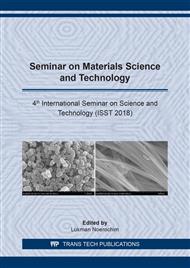[1]
Kikku Fukushima, Meng-Hsiu Wu a, Sergio Bocchini, Amaliya Rasyida, Ming-Chien Yang. 2012. PBAT based nanocomposites for medical and industrial applications, Materials Science and Engineering C 32 (2012) 1331–1351.
DOI: 10.1016/j.msec.2012.04.005
Google Scholar
[2]
Sun, Jinchen, and Huaping Tan. 2013. Alginate-Based Biomaterials for Regenerative Medicine Applications., Materials 6 (4): 1285–1309. https://doi.org/10.3390/ma6041285.
DOI: 10.3390/ma6041285
Google Scholar
[3]
Venkatesan, Jayachandran, Ira Bhatnagar, Panchanathan Manivasagan, Kyong Hwa Kang, and Se Kwon Kim. 2015. Alginate Composites for Bone Tissue Engineering: A Review., International Journal of Biological Macromolecules 72: 269–81. https://doi.org/10.1016/j.ijbiomac.2014.07.008.
DOI: 10.1016/j.ijbiomac.2014.07.008
Google Scholar
[4]
Cho, Sang Ho, Sung Mook Lim, and Dong Keun Han. 2012. Journal of Biomaterials Science , Time-Dependent Alginate / Polyvinyl Alcohol Hydrogels as Injectable Cell Carriers,, no. April 2013: 863–76.
DOI: 10.1163/156856209x444312
Google Scholar
[5]
Yan, Jingxuan, Yuting Miao, Huaping Tan, Tianle Zhou, Zhonghua Ling, Yong Chen, Xiaodong Xing, and Xiaohong Hu. 2016. Injectable Alginate/Hydroxyapatite Gel Scaffold Combined with Gelatin Microspheres for Drug Delivery and Bone Tissue Engineering., Materials Science and Engineering C 63: 274–84. https://doi.org/10.1016/j.msec.2016.02.071.
DOI: 10.1016/j.msec.2016.02.071
Google Scholar
[6]
Amaliya Rasyida, Thalyta Rizkha Pradipta, Sigit Tri Wicaksono. Studi Pengaruh Penambahan PVA dan Bentonit Terhadap Morfologi dan Sifat Fisik Komposit Berbasis Hidrogel Alginat sebagai Kandidat Material Perancah untuk Regenarasi Tulang Rawan. JURNAL TEKNIK ITS Vol. 7, No. 2, (2018) ISSN: 2337-3539 (2301-9271 Print).
DOI: 10.12962/j23373539.v7i2.42611
Google Scholar
[7]
Rottensteiner, Ulrike, Bapi Sarker, Dominik Heusinger, Diana Dafinova, Subha N. Rath, Justus P. Beier, Ulrich Kneser, et al. 2014. In Vitro and in Vivo Biocompatibility of Alginate Dialdehyde/Gelatin Hydrogels with and without Nanoscaled Bioactive Glass for Bone Tissue Engineering Applications., Materials 7 (3): 1957–74. https://doi.org/10.3390/ma7031957.
DOI: 10.3390/ma7031957
Google Scholar
[8]
Gaaz, Tayser Sumer, Abu Bakar Sulong, Majid Niaz Akhtar, Abdul Amir H. Kadhum, Abu Bakar Mohamad, Ahmed A. Al-Amiery, and Derek J. McPhee. 2015. Properties and Applications of Polyvinyl Alcohol, Halloysite Nanotubes and Their Nanocomposites., Molecules 20 (12): 22833–47. https://doi.org/10.3390/molecules201219884.
DOI: 10.3390/molecules201219884
Google Scholar
[9]
Li, Ming, Pan Xiong, Feng Yan, Sijie Li, Changhong Ren, Zhichen Yin, Ang Li, et al. 2018. An Overview of Graphene-Based Hydroxyapatite Composites for Orthopedic Applications., Bioactive Materials 3 (1): 1–18. https://doi.org/10.1016/j.bioactmat.2018.01.001.
DOI: 10.1016/j.bioactmat.2018.01.001
Google Scholar
[10]
Kadambinee Sa, Prakash C. Mahakul, B.V.R.S. Subramanyam, Jagatpati Raiguru, Sonali Das, Injamul Alam, Pitamber Mahanandi (2018). Effect of reduced graphene oxide-carbon nanotubes hybrid nanofillers in mechanical properties of polymer nanocomposites IOP Conf. Series: Materials Science and Engineering 338 (2018) 012055.
DOI: 10.1088/1757-899x/338/1/012055
Google Scholar
[11]
Yan Shi, Dangsheng Xiong, Jianliang Li, Kun Wang and Nan Wang. In situ repair of graphene defects and enhancement of its reinforcement effect in polyvinyl alcohol hydrogels. RSC Adv., 2017, 7, 1045–1055.
DOI: 10.1039/c6ra24949c
Google Scholar
[12]
Fatima Zia, Hadi Sobhani, Mohsen Mohammadi, Makshoof Athar, Muhammad Afzal, Tayyaba Sultana, Yury Shchipunov. Alginate-Based Hybrid Nanocomposite Materials. Chemistry, Biotechnology and Materials Science 2017, Pages 603-648 http://dx.doi.org/10.1016/B978-0-12-812360-7.00017-3.
DOI: 10.1016/b978-0-12-812360-7.00017-3
Google Scholar
[13]
Nasim Golafshana, R.Rezahasani et al.Nanohybrid hydrogels of laponite: PVA-Alginate as a potential wound healing material.. Carbohydrate Polymers (2017). Volume 176, Pages 392-401.
DOI: 10.1016/j.carbpol.2017.08.070
Google Scholar
[14]
Lu Zhang, Zhipeng Wang, Chen Xu, Yi Li, Jianping Gao, Wei Wang and Yu Liu. High strength graphene oxide/polyvinyl alcohol composite hydrogels J. Mater. Chem. (2011), 21, 10399.
DOI: 10.1039/c0jm04043f
Google Scholar


